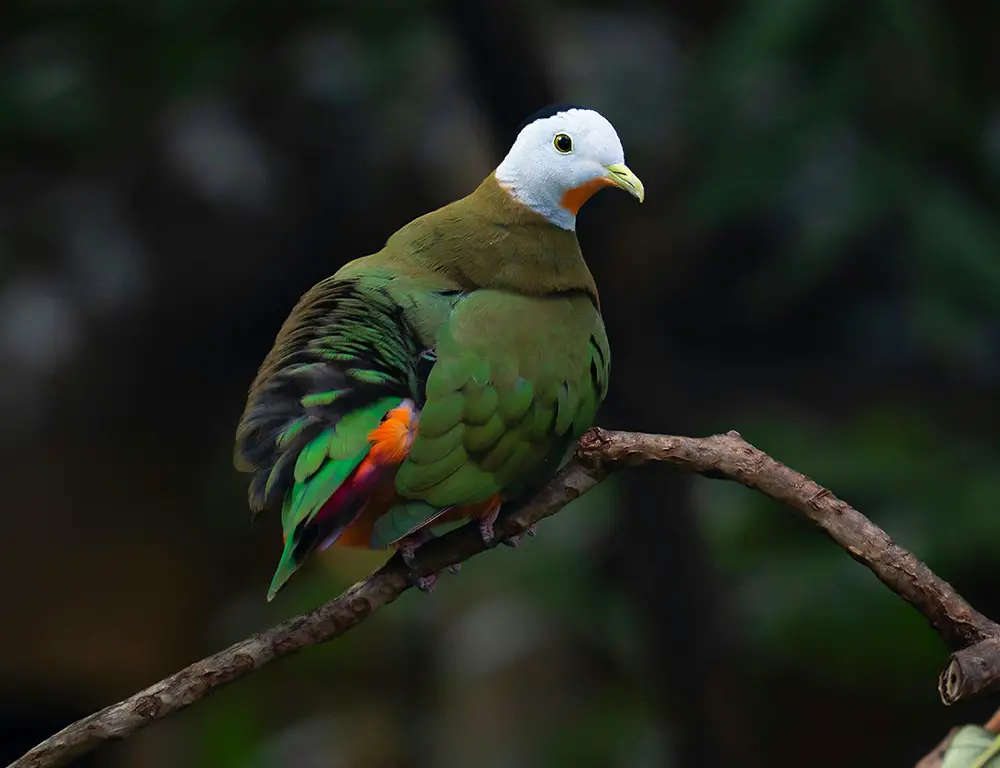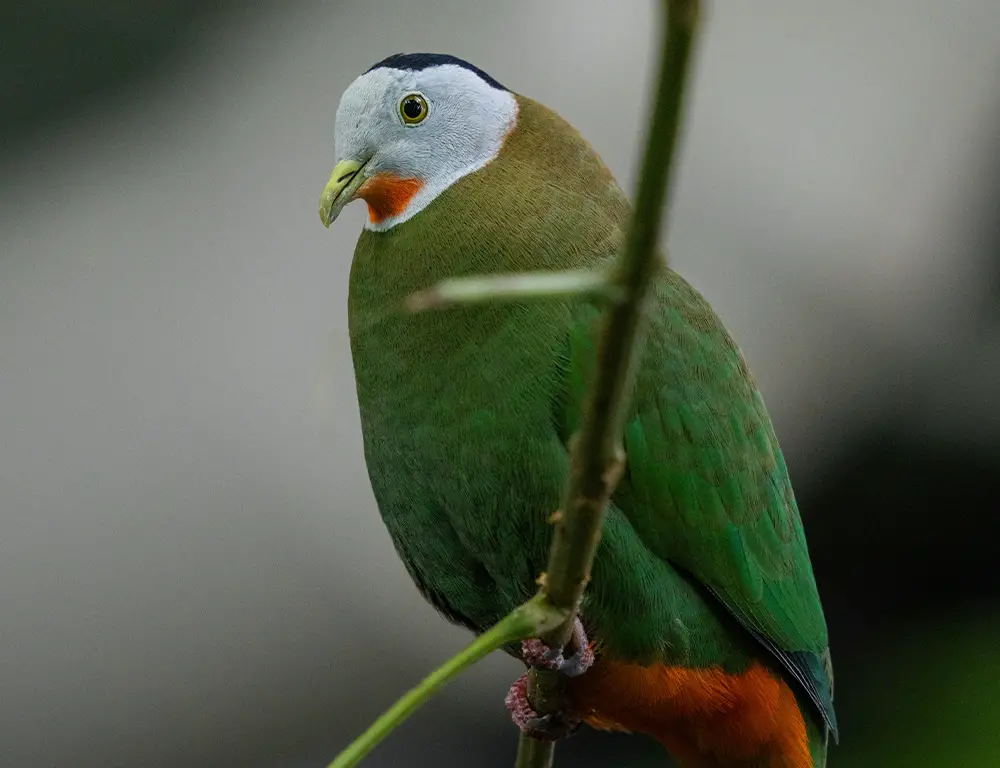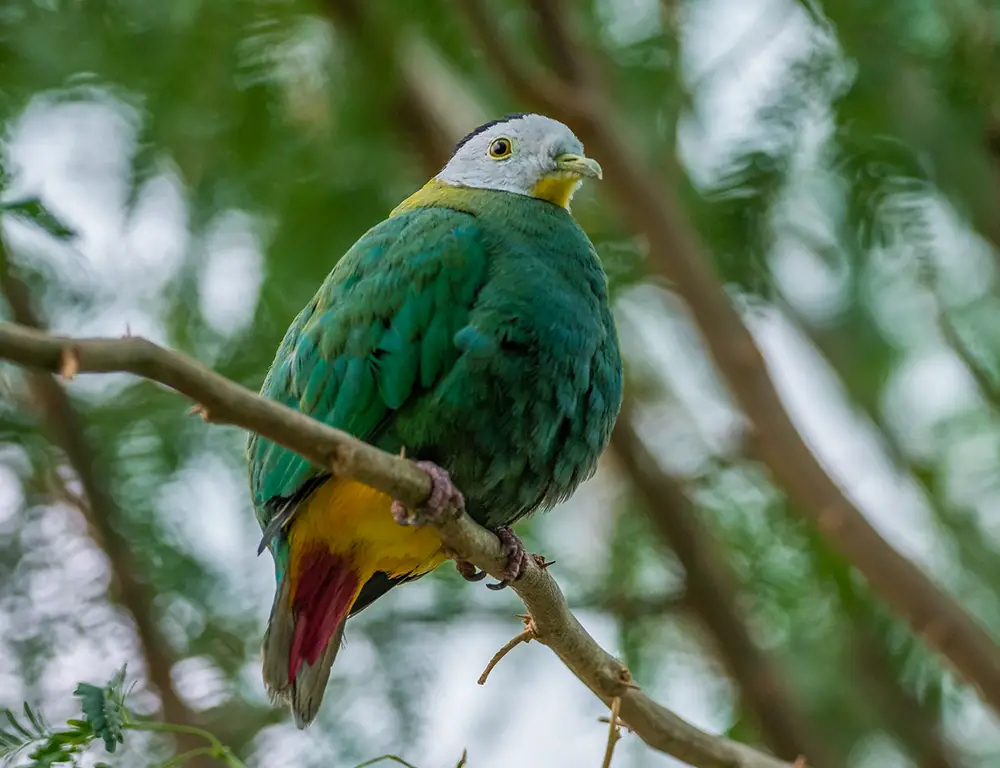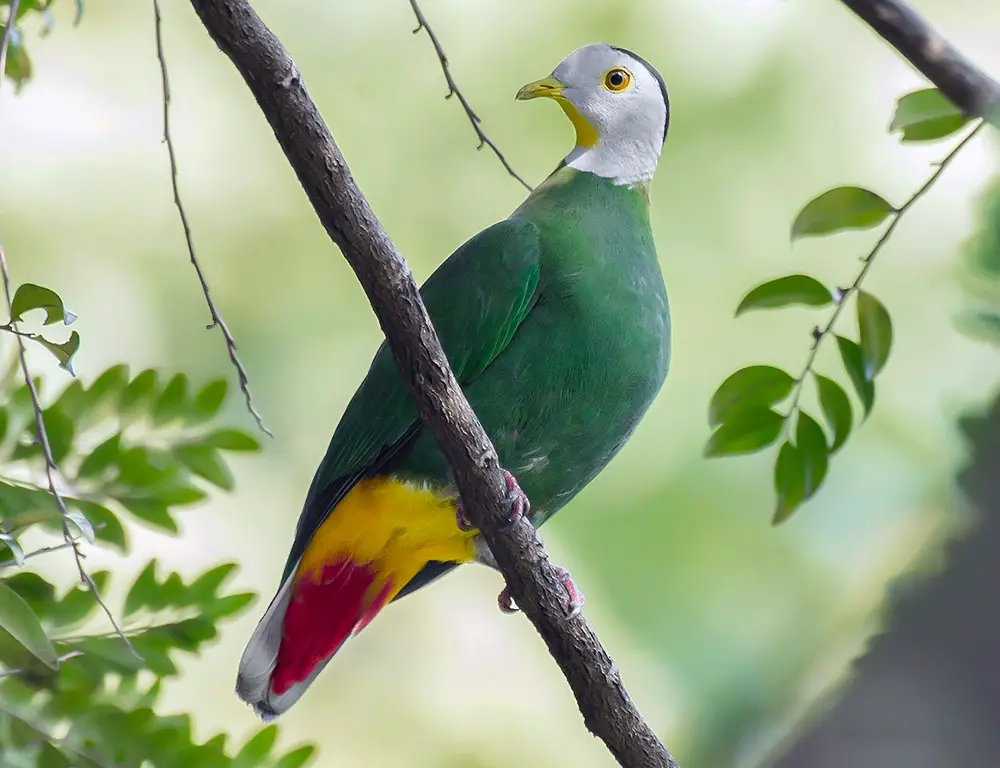In the vibrant realm of avian biodiversity, the Black-Naped Fruit Dove stands as a remarkable specimen, captivating enthusiasts with distinctive traits.
Found predominantly in the tropical rainforests of Southeast Asia, this dove, scientifically known as Ptilinopus melanospilus, boasts a stunning palette of colors—from its green wings to its orange belly and the defining black nape.
Beyond its striking appearance, it serves as a frugivore, primarily feeding on fruits, showcasing a vital role in its ecosystem’s seed dispersal.
As a solitary creature by nature, yet pivotal in maintaining ecological balance, the Black-Naped Fruit Dove offers a profound testament to the interconnectedness of our natural world. Join me as we delve deeper into the intriguing world of this extraordinary bird species.

Physical Characteristics of Black-Naped Fruit Doves
The physical characteristics of the Black-Naped Fruit Dove (Ptilinopus melanospilus) contribute to its unique appearance and lifestyle in its native Southeast Asian habitats. Here’s a detailed look at its physical traits:
Plumage
The Black-Naped Fruit Dove exhibits a vibrant and colorful plumage, with distinct differences between males and females. Males typically have grey heads, yellow throats, and green wings.
One of their most defining features is the black patch on the nape of their necks, which gives them their name. Additionally, males often have patches of golden feathers on their backs. Female doves have a more subdued greenish hue overall.
Size
These doves are relatively small, measuring between 23 and 28 centimeters (approximately 9 and 11 inches) in length. They are considered petite compared to other bird species.
Weight
While specific weight measurements may vary, Black-Naped Fruit Doves generally weigh 133 to 179 grams (approximately 4.7 to 6.3 ounces). This weight range contributes to their agility and ability to maneuver through their forest habitats.
Sexual Dimorphism
One notable aspect of the Black-Naped Fruit Dove is its sexual dimorphism, where males and females have distinct physical differences. Males typically exhibit more vibrant colors and markings, such as the pinkish-red chest, while females have a more muted coloration.
Adaptations for Survival
The plumage of the Black-Naped Fruit Dove serves aesthetic and functional purposes. For example, the greenish hue of the female’s plumage acts as camouflage among the foliage, helping to protect them from predators while nesting.
Habitat and Distribution of the Black-Naped Fruit Dove

The Black-Naped Fruit Dove (Ptilinopus melanospilus) is native to Southeast Asia’s lush tropical rainforests and coastal regions.
Here’s a detailed look at its habitat and distribution:
Habitat
- Tropical Rainforests: Black-Naped Fruit Doves are primarily found in dense tropical rainforests, with access to diverse fruit-bearing trees. These habitats provide abundant food sources and suitable nesting sites for the doves.
- Coastal Mangroves: Besides rainforests, these doves inhabit coastal mangrove forests. Mangrove ecosystems offer a mix of terrestrial and aquatic environments, with various fruiting plants that attract the doves.
- Human-Dominated Landscapes: While their preferred habitats are undisturbed rainforests and mangroves, Black-Naped Fruit Doves have demonstrated adaptability to human-dominated landscapes. They may be found in plantations, including coconut groves, where fruit trees provide food and shelter.
Distribution
- Geographical Range: The Black-Naped Fruit Dove’s distribution spans a broad area across Southeast Asia. They are found in Thailand, Malaysia, Indonesia, the Philippines, and East Timor.
- Specific Locations: Black-Naped Fruit Doves inhabit various islands and regions within these countries. They can be found in both mainland Southeast Asia and the numerous islands of the Indonesian archipelago.
- Altitudinal Range: While typically found in lowland areas, Black-Naped Fruit Doves may also occur at higher elevations within their range, especially in mountainous regions with suitable habitats.
- Preferred Microhabitats: Within their range, these doves favor areas with abundant fruit trees and dense vegetation. They may be found roosting and foraging in the canopy of tall trees or seeking shelter in thick undergrowth.
Behavior of the Black-Naped Fruit Dove

The behavior of the Black-Naped Fruit Dove (Ptilinopus melanospilus) encompasses various aspects of foraging, communication, and social interactions. Here’s an overview of their behavior:
Foraging Behavior
- Frugivorous Diet: Black-Naped Fruit Doves are primarily frugivores, meaning they mainly feed on fruits. They have a preference for a variety of fruits, including figs, berries, and drupes.
- Foraging Habits: These doves are active foragers, moving through the forest canopy in search of ripe fruits. They have been observed feeding in both primary and secondary forests and human-modified landscapes such as plantations and gardens with fruit trees.
- Seed Dispersal: By consuming fruits and later excreting the seeds, Black-Naped Fruit Doves play an essential role in seed dispersal within their habitats, contributing to the regeneration of forest vegetation.
Communication
- Vocalizations: Black-Naped Fruit Doves communicate through vocalizations, including soft cooing calls. Males are known for their distinctive cooing calls, particularly during mating.
- Body Language: Besides vocalizations, these doves communicate through body language. During courtship displays or territorial disputes, males may puff up their chests and extend their wings to establish dominance or attract mates.
Social Behavior
- Solitary Nature: Black-Naped Fruit Doves are generally solitary birds outside the breeding season. They may form small groups or pairs during courtship and mating but tend to forage and roost alone.
- Territorial Behavior: Males may exhibit territorial behavior, especially during the breeding season, to defend nesting territories and attract mates.
- Pair Bonding: During courtship, males display elaborate displays to court females. Once paired, they may engage in mutual preening and other bonding behaviors.
Reproductive Behavior
- Nesting: Black-Naped Fruit Doves typically nest in tree hollows or dense foliage, where females lay their eggs. They may select nesting sites high up in the canopy for protection against predators.
- Incubation and Parental Care: After the eggs are laid, male and female doves take turns incubating the eggs and caring for the chicks once they hatch. This shared parental care contributes to the survival of the offspring.
Conservation Status of the Black-Naped Fruit Dove

The conservation status of the Black-Naped Fruit Dove (Ptilinopus melanospilus) is of concern due to various threats, primarily habitat loss and degradation.
Here’s an overview of its conservation status:
IUCN Red List Status
The IUCN Red List categorizes the Black-Naped Fruit Dove as “Near Threatened” (NT). This designation indicates that the species risk becoming endangered if conservation efforts are not implemented to mitigate threats.
Primary Threats
Human activities, particularly land development and deforestation, are the primary threats to the Black-Naped Fruit Dove’s survival.
Habitat loss deprives these birds of their essential food sources and nesting sites, contributing to population decline and fragmentation.
Conservation Efforts
Despite the bleak situation, ongoing conservation efforts aim to protect the Black-Naped Fruit Dove and its habitat. These efforts include:
Habitat Restoration
Organizations are actively restoring degraded habitats by replanting native fruit trees in areas affected by deforestation. Habitat restoration initiatives aim to create suitable habitats for the doves and promote ecosystem health.
Public Education
Public awareness campaigns, seminars, and workshops are conducted to educate local communities and the general public about preserving habitats and biodiversity.
By raising awareness, these efforts seek to garner support for conservation actions and sustainable land use practices.
Legal Protection
Advocacy efforts are underway to advocate for legal protection measures for the Black-Naped Fruit Dove and its habitats. Legal protections can help enforce regulations against habitat destruction, illegal logging, and wildlife trade, providing critical safeguards for the species.
Hope for the Future
Despite the challenges facing the Black-Naped Fruit Dove, conservationists remain hopeful that concerted efforts can reverse the species’ decline and secure its long-term survival.
By continuing to implement conservation measures, raise public awareness, and advocate for policy changes, there is optimism that we can make a positive difference for this beautiful bird species.
To put this into perspective:
| Year | Estimated Population |
|---|---|
| 1990 | 1,000,000 |
| 2000 | 800,000 |
| 2010 | 500,000 |
| 2020 | Less than 300,000 |
Conclusion
The Black-Naped Fruit Dove is a captivating emblem of nature’s intricate beauty. Through our exploration, we’ve uncovered its unique traits, from vibrant plumage to elaborate mating rituals, all underscored by a profound dependence on its forest habitat and fruit trees.
As stewards of our environment, we must prioritize conservation efforts to protect these vital ecosystems.
By understanding and preserving species’ habitats like the Black-Naped Fruit Dove, we safeguard their survival and uphold the delicate balance of our natural world.
Let our appreciation for these remarkable creatures inspire us towards concerted action in conservation, ensuring a brighter future for them and our planet.